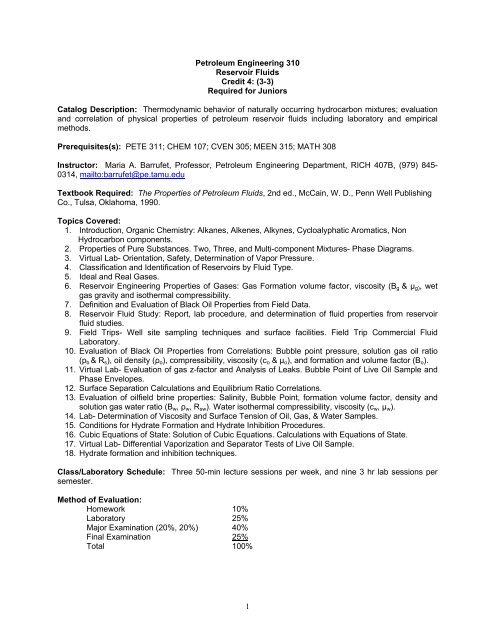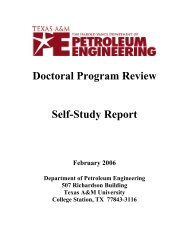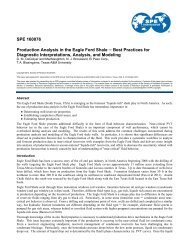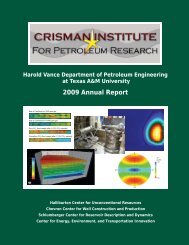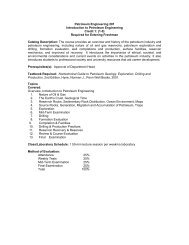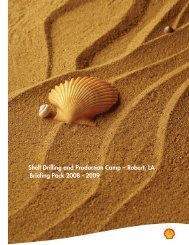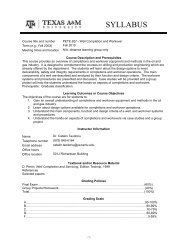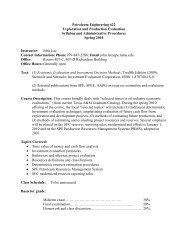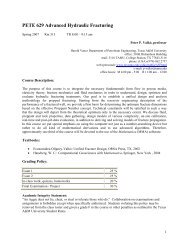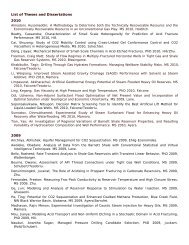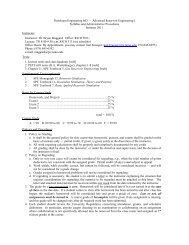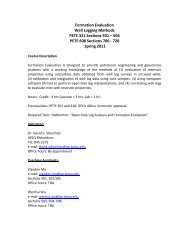Nontechnical Guide to Petroleum Geology, Exploration
Nontechnical Guide to Petroleum Geology, Exploration
Nontechnical Guide to Petroleum Geology, Exploration
Create successful ePaper yourself
Turn your PDF publications into a flip-book with our unique Google optimized e-Paper software.
<strong>Petroleum</strong> Engineering 310<br />
Reservoir Fluids<br />
Credit 4: (3-3)<br />
Required for Juniors<br />
Catalog Description: Thermodynamic behavior of naturally occurring hydrocarbon mixtures; evaluation<br />
and correlation of physical properties of petroleum reservoir fluids including labora<strong>to</strong>ry and empirical<br />
methods.<br />
Prerequisites(s): PETE 311; CHEM 107; CVEN 305; MEEN 315; MATH 308<br />
Instruc<strong>to</strong>r: Maria A. Barrufet, Professor, <strong>Petroleum</strong> Engineering Department, RICH 407B, (979) 845-<br />
0314, mail<strong>to</strong>:barrufet@pe.tamu.edu<br />
Textbook Required: The Properties of <strong>Petroleum</strong> Fluids, 2nd ed., McCain, W. D., Penn Well Publishing<br />
Co., Tulsa, Oklahoma, 1990.<br />
Topics Covered:<br />
1. Introduction, Organic Chemistry: Alkanes, Alkenes, Alkynes, Cycloalyphatic Aromatics, Non<br />
Hydrocarbon components.<br />
2. Properties of Pure Substances. Two, Three, and Multi-component Mixtures- Phase Diagrams.<br />
3. Virtual Lab- Orientation, Safety, Determination of Vapor Pressure.<br />
4. Classification and Identification of Reservoirs by Fluid Type.<br />
5. Ideal and Real Gases.<br />
6. Reservoir Engineering Properties of Gases: Gas Formation volume fac<strong>to</strong>r, viscosity (B g & μ g) , wet<br />
gas gravity and isothermal compressibility.<br />
7. Definition and Evaluation of Black Oil Properties from Field Data.<br />
8. Reservoir Fluid Study: Report, lab procedure, and determination of fluid properties from reservoir<br />
fluid studies.<br />
9. Field Trips- Well site sampling techniques and surface facilities. Field Trip Commercial Fluid<br />
Labora<strong>to</strong>ry.<br />
10. Evaluation of Black Oil Properties from Correlations: Bubble point pressure, solution gas oil ratio<br />
(p b & R s ), oil density (ρ o ), compressibility, viscosity (c o & μ o ), and formation and volume fac<strong>to</strong>r (B o ).<br />
11. Virtual Lab- Evaluation of gas z-fac<strong>to</strong>r and Analysis of Leaks. Bubble Point of Live Oil Sample and<br />
Phase Envelopes.<br />
12. Surface Separation Calculations and Equilibrium Ratio Correlations.<br />
13. Evaluation of oilfield brine properties: Salinity, Bubble Point, formation volume fac<strong>to</strong>r, density and<br />
solution gas water ratio (B w , ρ w , R sw ). Water isothermal compressibility, viscosity (c w , μ w ).<br />
14. Lab- Determination of Viscosity and Surface Tension of Oil, Gas, & Water Samples.<br />
15. Conditions for Hydrate Formation and Hydrate Inhibition Procedures.<br />
16. Cubic Equations of State: Solution of Cubic Equations. Calculations with Equations of State.<br />
17. Virtual Lab- Differential Vaporization and Separa<strong>to</strong>r Tests of Live Oil Sample.<br />
18. Hydrate formation and inhibition techniques.<br />
Class/Labora<strong>to</strong>ry Schedule: Three 50-min lecture sessions per week, and nine 3 hr lab sessions per<br />
semester.<br />
Method of Evaluation:<br />
Homework 10%<br />
Labora<strong>to</strong>ry 25%<br />
Major Examination (20%, 20%) 40%<br />
Final Examination 25%<br />
Total 100%<br />
1


